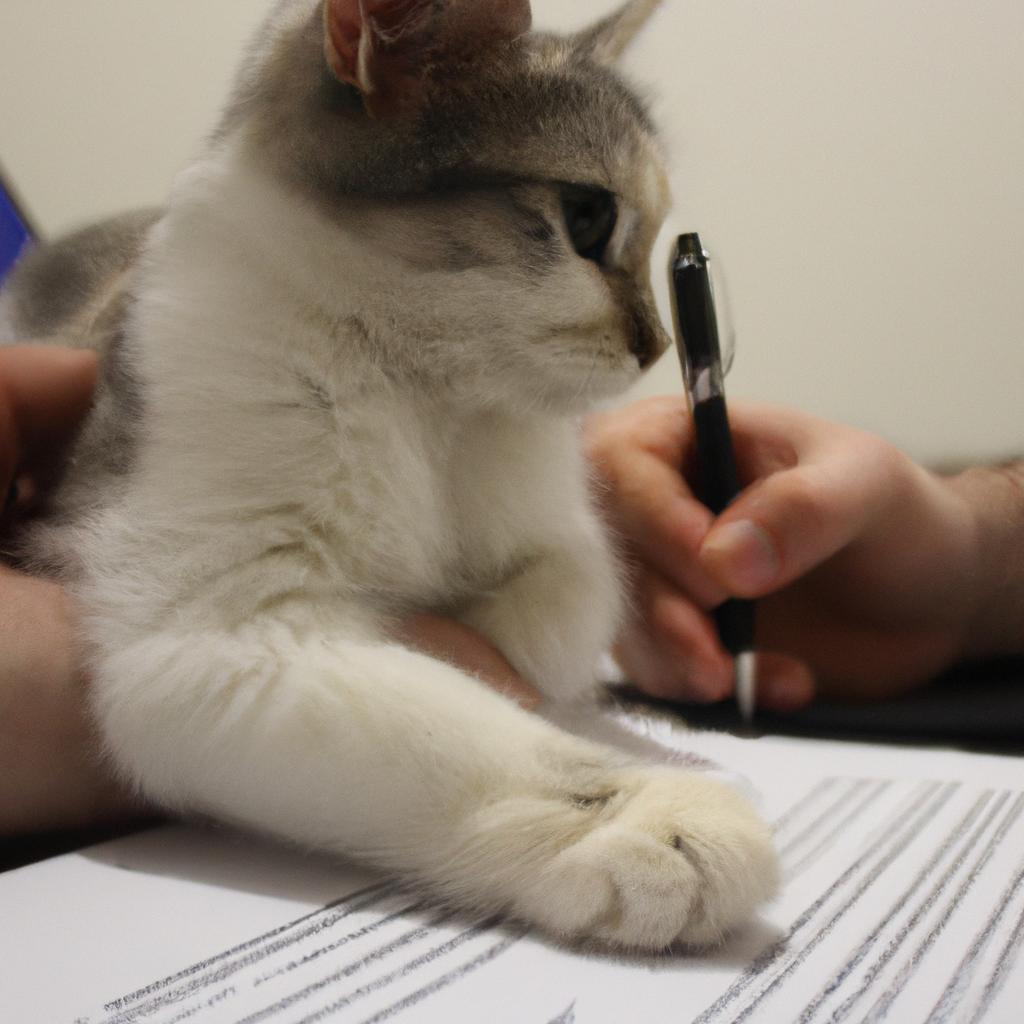In times of crisis, cat rescue organizations often face significant challenges in securing the necessary funding to continue their lifesaving work. Emergency grants have emerged as a vital resource for these organizations, providing them with immediate financial assistance during difficult times. For instance, consider the case of Cat Rescue Society (CRS), a non-profit organization dedicated to rescuing and rehabilitating stray cats. When CRS experienced an unexpected surge in abandoned kittens due to a natural disaster, they found themselves overwhelmed by the sudden increase in expenses required for veterinary care, food, and shelter. However, through the timely acquisition of emergency grants, CRS was able to not only meet the urgent needs of these vulnerable felines but also maintain its operations and sustain its mission.
The significance of emergency grants lies in their ability to provide crucial support when traditional sources of funding may be insufficient or inaccessible during emergencies. These grants offer temporary relief to cat rescue organizations facing unforeseen circumstances such as large-scale disasters or economic downturns that strain their resources beyond capacity. By addressing the immediate financial needs arising from these crises, emergency grants enable organizations like CRS to mitigate the adverse impact on animal welfare and ensure continuity in their efforts towards saving lives. As more attention is being drawn towards animal advocacy and protection, understanding the intricacies of securing emergency grants becomes increasingly important for cat rescue organizations.
There are several key factors to consider when seeking emergency grants for cat rescue organizations. Firstly, it is crucial to research and identify potential grant opportunities that specifically cater to animal welfare or disaster relief efforts. Many foundations, government agencies, and private organizations offer emergency funding for such purposes.
Furthermore, preparing a strong grant proposal is essential to increase the chances of securing funding. The proposal should clearly outline the organization’s mission, the specific crisis or emergency situation it is facing, and how the funds will be utilized to address immediate needs. Providing detailed information about the number of cats affected, their medical requirements, and anticipated costs will help demonstrate the urgency and importance of financial assistance.
Additionally, building relationships with funders and maintaining open lines of communication can greatly enhance the likelihood of receiving emergency grants. Networking with other animal welfare organizations and attending relevant conferences or events may provide opportunities to connect with potential funders.
Lastly, being transparent about financial management practices and demonstrating accountability in previous grant usage can instill confidence in funders regarding the responsible use of emergency funds.
In conclusion, securing emergency grants plays a vital role in supporting cat rescue organizations during times of crisis. By diligently researching grant opportunities, crafting compelling proposals, nurturing relationships with funders, and showcasing transparency in financial management, these organizations can better position themselves to receive much-needed financial assistance.
Understanding the Need for Emergency Grants
In times of crisis, such as natural disasters or economic downturns, animal rescue organizations often find themselves struggling to meet the needs of their feline wards. For instance, consider a hypothetical case where a cat shelter in a coastal town is hit by a hurricane, leaving them with limited resources and an influx of displaced cats. The urgency to provide immediate care and support for these animals becomes paramount. This is where emergency grants play a crucial role in securing funding to address the pressing needs and ensure the welfare of rescued cats.
To fully comprehend the significance of emergency grants, it is essential to acknowledge the challenges faced by cat rescue organizations during crises. Firstly, financial constraints can severely limit their ability to access necessary supplies, including food, medication, and veterinary services. Without adequate funding, shelters may struggle to maintain proper hygiene standards and provide appropriate medical attention to sick or injured cats. Secondly, emergencies often result in an increase in stray or abandoned cats that require temporary housing until they can be reunited with their owners or placed into permanent homes. These sudden surges place additional strain on already stretched resources.
The implications of insufficient funding extend beyond basic necessities; they have profound consequences for both individual cats and society at large. When shelters lack funds due to unforeseen circumstances like natural disasters or economic downturns, there are adverse effects on cat health outcomes and potentially higher euthanasia rates due to overcrowding or inability to provide needed medical treatment promptly. Moreover, without proper intervention during crisis situations, there could be negative implications for public health and safety as unattended stray populations proliferate.
Consider the following emotional responses when contemplating these facts:
- Sympathy: Imagining helpless kittens going hungry due to lack of resources
- Empathy: Feeling connected with those who dedicate their lives to rescuing vulnerable animals
- Concern: Worrying about potential disease outbreaks if abandoned cats aren’t cared for properly
- Urgency: Feeling compelled to take action and support these organizations in their time of need
| Emotional Responses |
|---|
| Sympathy |
| Empathy |
| Concern |
| Urgency |
In light of the significant impact emergency grants can have on cat rescue operations, it becomes imperative to explore potential sources of funding. By identifying and understanding these possibilities, shelters can better prepare for crises and ensure the continued well-being of rescued felines.
Transitioning into the subsequent section about “Identifying Potential Sources of Funding,” an exploration of various avenues through which cat rescue organizations may seek financial assistance will be undertaken.
Identifying Potential Sources of Funding
In a time of crisis, such as a natural disaster or an unexpected influx of abandoned cats, securing funding is crucial for cat rescue organizations to continue their life-saving work. One example that highlights the importance of emergency grants is the devastating hurricane that hit a coastal town last year. The local cat shelter was severely affected, with its facilities damaged and resources depleted. Without immediate financial support, they would not have been able to provide necessary care for the cats in their custody.
To effectively secure emergency grants for cat rescue during times of crisis, it’s essential to identify potential sources of funding. Here are some key considerations:
- Government Agencies: Local, state, and federal government agencies often provide emergency funds for animal welfare organizations during disasters or emergencies.
- Foundations and Nonprofit Organizations: Many foundations and nonprofit organizations offer grant opportunities specifically tailored to supporting animal rescue efforts in times of crisis.
- Corporate Sponsorship Programs: Companies committed to corporate social responsibility may have sponsorship programs that support animal-related causes during emergencies.
- Community Fundraising Initiatives: Engaging the community through fundraising events and campaigns can help generate support and raise awareness about the need for emergency grants.
The table below illustrates various examples of potential funding sources:
| Funding Source | Description | Grant Amounts Available |
|---|---|---|
| Federal Disaster Relief Funds | Provided by FEMA (Federal Emergency Management Agency) to assist communities in recovering from major disasters | Up to $500,000 |
| Animal Welfare Foundation Grants | Dedicated foundations aimed at addressing animal welfare issues | Range from $5,000 – $50,000 |
| Corporate Social Responsibility Programs | Sponsorship initiatives offered by companies committed to making a positive impact on society | Varies based on company guidelines |
| Crowdfunding Campaigns | Online platforms allow individuals to donate towards specific causes or projects within a set timeframe | Potential donations range widely |
By understanding the need for emergency grants and identifying potential funding sources, cat rescue organizations can increase their chances of securing essential financial support during times of crisis. The next section will focus on preparing a compelling grant proposal to effectively communicate the organization’s mission and needs.
Transitioning into the subsequent section about “Preparing a Compelling Grant Proposal,” it is crucial for cat rescue organizations to present their case in a persuasive manner that captures the attention of funders.
Preparing a Compelling Grant Proposal
Section H2: Preparing a Compelling Grant Proposal
Transitioning from the previous section on identifying potential sources of funding, it is now crucial to focus on preparing a compelling grant proposal. To illustrate the importance of this step, let us consider a hypothetical case study involving an organization dedicated to cat rescue in crisis situations.
Imagine that Cat Haven, a nonprofit cat shelter, has identified several potential funding sources for their emergency grants. They have narrowed down their options and are ready to move forward with crafting persuasive proposals. This next phase requires careful planning and attention to detail to maximize their chances of securing the necessary funds.
When preparing a compelling grant proposal, there are key elements to keep in mind:
- Clearly articulate the need: Highlight the urgency and significance of addressing the specific challenges faced by cat rescue organizations during crises.
- Demonstrate impact: Provide concrete examples or data illustrating how effective interventions can make a difference in saving feline lives.
- Develop a comprehensive budget: Detail how every dollar will be allocated towards essential resources such as veterinary care, food supplies, and temporary shelters.
- Establish credibility and trustworthiness: Showcase Cat Haven’s track record, expertise, partnerships, and any endorsements they may have received from reputable organizations.
To evoke an emotional response from funders who deeply care about animal welfare, consider these points:
- The heartbreaking reality of cats left abandoned during natural disasters
- Stories of successful rescues leading to happy adoption outcomes
- Testimonials from volunteers whose lives were positively impacted through their involvement with Cat Haven
- A comparison between providing timely assistance versus potentially dire consequences without intervention
Additionally, presenting information visually can further engage readers and appeal to their emotions. Consider incorporating tables into your proposal:
| Rescue Expenses | Estimated Cost |
|---|---|
| Veterinary Care | $10,000 |
| Food Supplies | $5,000 |
| Temporary Shelters | $7,500 |
| Staff Training | $2,500 |
In conclusion, preparing a compelling grant proposal is essential for securing emergency funding. By effectively communicating the need, demonstrating impact, developing a comprehensive budget, and establishing credibility, organizations like Cat Haven can increase their chances of receiving support. The subsequent section will delve into navigating the application process seamlessly.
Transitioning seamlessly into the subsequent section about “Navigating the Application Process,” it is crucial to understand the necessary steps involved in bringing your carefully crafted grant proposal to fruition.
Navigating the Application Process
Building on the foundation of a compelling grant proposal, this section will delve into the crucial step of navigating the application process for emergency grants. Understanding the ins and outs of this process is essential in securing funding for cat rescue organizations facing crisis situations. Let us explore how to effectively navigate through the various stages involved.
To illustrate these steps, let’s consider a hypothetical case study involving a cat rescue organization called “Pawsome Haven.” Pawsome Haven has been providing shelter and care for abandoned cats in their community for over a decade but finds itself in dire need of financial assistance due to an unexpected increase in rescued animals following a natural disaster.
- Researching Grant Opportunities:
- Begin by identifying potential grant opportunities specific to animal welfare or emergency relief.
- Consult online databases, such as Grants.gov or Foundation Directory Online, which provide comprehensive listings of available grants.
- Explore local foundations and philanthropic organizations that may have initiatives aligned with your cause.
- Establish contact with like-minded individuals or organizations who can provide insights into possible sources of funding.
- Carefully Reviewing Guidelines:
- Once you identify potential grants, thoroughly review each program’s guidelines and eligibility criteria.
- Pay close attention to any restrictions or requirements regarding project timelines, budget allocations, reporting obligations, etc.
- Highlight key points within the guidelines that align with Pawsome Haven’s mission and needs based on its current circumstances.
- Developing a Comprehensive Plan:
- Craft a detailed plan outlining how Pawsome Haven intends to utilize funds from each identified grant opportunity.
- Clearly articulate goals and objectives that directly address the challenges faced during the crisis period.
- Create a realistic timeline highlighting specific activities and milestones associated with implementing proposed projects.
- Consider developing partnerships or collaborations with other stakeholders where appropriate to maximize impact.
- Submitting Applications:
Once all preparations are complete, it is time to submit applications for relevant grants. Ensure that all required documentation, including budgets, letters of support, and supporting materials, are compiled accurately and submitted before the deadline. Maintain thorough records of each submission for future reference.
In navigating the application process successfully, cat rescue organizations like Pawsome Haven can increase their chances of securing emergency grants to support their vital work during crises. By conducting diligent research, adhering to guidelines, developing comprehensive plans, and submitting well-prepared applications in a timely manner, these organizations can take significant steps towards obtaining the necessary funding to ensure the welfare and safety of vulnerable cats.
Moving forward into managing and reporting grant funds efficiently is paramount for cat rescue organizations. Let us now explore this crucial aspect to ensure effective utilization of secured resources.
Managing and Reporting Grant Funds
Section H2: Managing and Reporting Grant Funds
Once your cat rescue organization has successfully secured emergency grant funding, it is crucial to effectively manage and report the use of these funds. This section will provide guidance on navigating this process to ensure transparency, accountability, and compliance with grant requirements.
To illustrate this process, let’s consider a hypothetical scenario where a cat rescue organization named Pawsome Pals receives an emergency grant for $10,000. They are required to use the funds within six months and submit a detailed report showcasing their financial expenditures and outcomes achieved through the grant.
When managing and reporting grant funds, there are several key considerations:
-
Financial Tracking:
- Maintain accurate records of all expenses related to the grant.
- Use accounting software or spreadsheets to track income and expenditures specifically tied to the grant.
- Regularly reconcile financial statements to identify any discrepancies.
-
Compliance with Grant Requirements:
- Familiarize yourself with the terms and conditions outlined in the grant agreement.
- Ensure that all spending aligns with the approved budget.
- Seek approval from the granting organization if any changes or deviations arise during implementation.
-
Outcome Measurement:
- Establish clear goals and objectives for how the grant funds will be utilized.
- Track progress towards these goals throughout the project timeline.
- Collect data and evidence demonstrating the impact of your initiatives supported by the grants.
-
Timely Reporting:
- Adhere to deadlines set by the granting organization for submitting interim reports or final evaluations.
- Prepare comprehensive reports detailing both financial information (expenditures) as well as programmatic results attained through the utilization of grant funds.
By adhering to these best practices when managing and reporting your cat rescue organization’s emergency grant funds, you can showcase responsible stewardship while strengthening trust with funders. Ensuring effective management allows you not only to fulfill your obligations but also presents opportunities for future collaboration and funding.
Transitioning into the subsequent section on “Ensuring Long-Term Financial Sustainability,” it is essential to look beyond emergency grants and focus on strategies that will provide continued financial support for your cat rescue organization.
Ensuring Long-Term Financial Sustainability
Building upon effective management and reporting of grant funds, the next crucial step in securing long-term financial sustainability for cat rescue organizations is to explore avenues for emergency grants. These grants provide a lifeline during crisis situations, ensuring that vital funding can be obtained swiftly and efficiently. To illustrate the importance of emergency grants, let us consider a hypothetical scenario where a cat rescue organization faces an unexpected surge in abandoned cats due to a natural disaster.
In times of crisis, such as natural disasters or unforeseen circumstances leading to increased demand for care, cat rescue organizations must proactively seek emergency grants to address immediate needs. For instance, imagine Cat Haven, located in a coastal region prone to hurricanes, suddenly finds itself overwhelmed with an influx of stray cats following a devastating storm. In this situation, obtaining emergency funding becomes paramount for providing essential veterinary care, nourishment, and shelter for these vulnerable felines.
To effectively secure emergency grants during crises like the one faced by Cat Haven, it is essential for cat rescue organizations to implement specific strategies:
- Maintain strong relationships with potential funders: By establishing and nurturing relationships with foundations and philanthropic individuals who prioritize animal welfare, organizations can increase their chances of receiving timely support during emergencies.
- Develop a comprehensive crisis response plan: Having a well-prepared strategy outlining steps to mitigate risks and address urgent needs will demonstrate professionalism when approaching potential donors.
- Clearly communicate impact and urgency: Providing accurate and compelling information about the current crisis’s scale and its effect on both individual cats’ lives and the broader community fosters understanding among prospective funders.
- Streamline application processes: Simplifying the grant application process specifically designed for emergency situations allows cat rescue organizations to access necessary funds quickly without delays or administrative burdens.
To emphasize the significance of securing emergency grants promptly during crises like natural disasters or sudden increases in abandonment rates at rescues centers, consider the following table showcasing potential consequences of delayed funding:
| Potential Consequences | Emotional Impact |
|---|---|
| Lack of veterinary care for injured cats | Anxiety and distress among volunteers |
| Insufficient food supply for rescued felines | Concern and sadness within the community |
| Overcrowding in shelters, compromising cat welfare | Frustration and helplessness among staff members |
| Inability to provide outreach programs for education and adoption | Disappointment and missed opportunities |
By highlighting these potential consequences, it becomes evident that securing emergency grants is not only vital for the immediate well-being of cats but also crucial for maintaining the emotional health of those involved in rescue efforts.
In summary, during times of crisis, such as natural disasters or unexpected surges in abandonment rates, securing emergency grants becomes a lifeline for cat rescue organizations. By establishing strong relationships with funders, developing comprehensive crisis response plans, effectively communicating impact and urgency, and streamlining application processes, organizations can increase their chances of obtaining timely support. Recognizing the emotional impact caused by delayed funding underscores the importance of swift action when seeking emergency grants.




